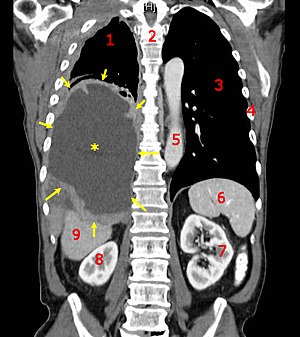Diagnosing mesothelioma isn't an easy task. As a matter of fact, a lot of physicians are even so unfamiliar with the symptoms that can be assigned to this cancer. Furthermore the symptoms of the disease don't usually manifest for a few years after contraction. This makes this disease even harder to be diagnosed at a right time and frequently it becomes too late for any doctor to do anything really constructive. So the first thing that you should do is to inform your doctor in advance if you are regularly exposed to asbestos. Otherwise after seeing the symptoms he may put those down to some other disease before testing for mesothelioma.
The diagnosis of begins with a CT or MRI scan to detect its presence and if the results show any positive sign then a biopsy is conducted. The initial scans help the doctor to view the affected area so that he can prepare a suitable plan to counter it. The doctor may do a minor operation to get a tissue sample of your lungs or other body part and run a biopsy on that. This is known as open pleural biopsy. While there are many other techniques to find the evidences of mesothelioma, experts consider pleural biopsy to be the most convincing way of diagnosing mesothelioma.
There are more than a few ways in which the doctor can perform a tissue biopsy in order to test for mesothelioma. A thoracoscopy or laparoscopy involves making a small cut and then keeping an eye over the infected area with the help of a tiny camera. Your doctor may do a needle biopsy in which a hollow needle is inserted into the chest cavity in order to collect a tissue sample which is then examined by the pathologist.
However, with open biopsy the doctor can collect a bigger tissue sample which makes mesothelioma diagnosis easier and even more precise which is why most physicians adhere to this technique. Once the tissue samples have been collected, a detailed examination of the cells is performed to check for malignant cells in the tissue. When all of this has been done, some more tests are performed to determine the extent of so that treatment can be done accordingly.
Saturday, August 8, 2009
Peritoneal Mesothelioma And What You Need To Know?
 Image via Wikipedia
Image via Wikipedia
While it is neither age nor sex particular, peritoneal mesothelioma is generally seen in men who are in the age bracket of 50-70 years. There are an amount of symptoms of peritoneal most of which begin coming out after 20, 30 or 50 years after the exposure to asbestos. These symptoms could include weight loss, hurting or swelling up in the abdomen, weakness, loss of appetite, intestine obstruction, anemia, nausea and fever. In addition to that, fluid often gathers in the peritoneal space leading to a condition called Ascites.
The first measure towards detection of peritoneal includes X-rays and CT scans. For official diagnosis, however the doctor wants to do a biopsy, whereby a piece of tissue is cut from the affected part of the victim’s body and is placed under microscope for examination. If the disease is detected at an early stage it stands better chance of getting cured than the state of diffuse peritoneal mesothelioma, where the cancer has already spread to various parts.
It is accurate that peritoneal is deadly and leads to a lot of deaths every year. However, with continued researches, several modes of treatments have been embarked upon and in the future there is a fair chance of the disease becoming absolutely curable. The types of treatment of peritoneal include surgery, radiation therapy and chemotherapy.
In surgery a part of the abdominal tissue is cut out to remove the tumor. At times the doctor may also need to remove a lung or a portion of the diaphragm as per the requirement of the surgery. Radiation therapy, the second method, requires the application of high energy X-rays to shrink the tumor and kill the malignant cells. The rays may be applied from an external machine or by placing the radiation source directly to the affected part of the body, by means of plastic tubes. Last treatment type is the chemotherapy whereby a combination of drugs is applied to kill the cancer cells. The drugs may be administered by mouth in the capsule form or may be applied intravenously via needle.
However, it is essential to mention that cost of treating any form of cancer is extravagant and you may consult a lawyer to earn you a handsome compensation from the authority who was responsible for your prior exposure to asbestos.
Labels:
Asbestos,
Cancer,
Chemotherapy,
Conditions and Diseases,
Health,
Mesothelioma
Subscribe to:
Posts (Atom)
![Reblog this post [with Zemanta]](http://img.zemanta.com/reblog_e.png?x-id=8ce514e6-f402-495f-b6ff-287e6030f80b)
![Reblog this post [with Zemanta]](http://img.zemanta.com/reblog_e.png?x-id=2bc379c8-d6af-43f8-9b84-48034a99847d)